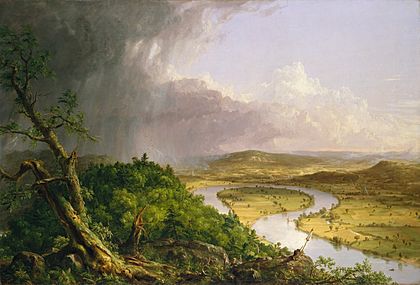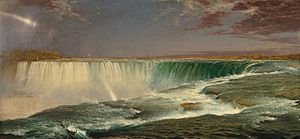Hudson River School facts for kids

The Hudson River School was a group of American landscape painters in the mid-1800s. Their art style was inspired by Romanticism, a movement that valued emotion and nature. These artists mainly painted the beautiful Hudson River Valley and nearby mountains. This included the Catskill, Adirondack, and White Mountains. Later, artists from this group also painted scenes from other parts of New England, Canada's the Maritimes, the American West, and even South America.
Contents
What Was the Hudson River School?
The name Hudson River School was likely first used by art critics. Some say it was Clarence Cook or painter Homer Dodge Martin. At first, the name was not meant as a compliment. This was because a new art style, the plein-air Barbizon School, became popular.
Paintings from the Hudson River School show three main ideas about America in the 1800s. These were discovery, exploration, and settlement. They also showed the American landscape as a peaceful place. Here, people and nature lived together happily. These artworks are known for being very realistic and detailed. They often showed calm farms next to wild, untouched nature. This wilderness was quickly disappearing from the Hudson Valley. Many artists believed that American nature showed the greatness of God. They were inspired by European artists like Claude Lorrain and J. M. W. Turner.
The Founder: Thomas Cole

Thomas Cole is seen as the person who started the Hudson River School. In the fall of 1825, he traveled up the Hudson River by steamship. He stopped at West Point and Catskill landing. Then, he hiked into the eastern Catskill Mountains to paint the area's first landscapes. A newspaper, the New York Evening Post, wrote about his work in November 1825. Cole was from England, and the bright autumn colors in America truly amazed him. His close friend Asher Brown Durand also became a very important artist in this group. The Hudson River School often focused on themes of national pride and the beauty of nature. The artists were also careful about the fast growth of industry and technology.
The Second Group of Artists
A "second generation" of Hudson River School artists appeared after Thomas Cole passed away in 1848. This group included Cole's student Frederic Edwin Church, John Frederick Kensett, and Sanford Robinson Gifford. Their paintings are often called examples of Luminism. This style uses light in a special way to create a calm, glowing effect. Kensett, Gifford, and Church also helped start the Metropolitan Museum of Art in New York City.
Many of the best works from this second group were painted between 1855 and 1875. Artists like Frederic Edwin Church and Albert Bierstadt were very famous during this time. Bierstadt even studied art in Germany for several years. Thousands of people would pay to see huge paintings like Niagara and The Icebergs. These giant landscapes were new to American art. They reminded Americans of the huge, wild, and amazing natural areas in their country. This was a time when people were settling the American West. It was also when national parks and city parks were being created.
Talented Female Artists
Several women were also part of the Hudson River School. Susie M. Barstow loved climbing mountains. She painted mountain scenes in the Catskills and White Mountains. Eliza Pratt Greatorex was an Irish-born painter. She was the second woman chosen to join the National Academy of Design. Julie Hart Beers led art trips in the Hudson Valley. She later opened an art studio in New York City with her daughters. Harriet Cany Peale studied with Rembrandt Peale. Mary Blood Mellen was a student and worked with Fitz Henry Lane.
The School's Lasting Impact
The art of the Hudson River School has become popular again at different times. Interest grew after World War I, perhaps due to strong feelings of national pride. Interest then faded until the 1960s. The growth of the Hudson Valley has also brought more attention to this art movement.
You can visit historic homes and sites dedicated to the Hudson River School. These include Olana State Historic Site in Hudson, New York. There's also the Thomas Cole National Historic Site in Catskill. The Newington-Cropsey Foundation has a museum and research library in Hastings-on-Hudson, New York. The John D. Barrow Art Gallery is in Skaneateles, New York.
Where to See the Art
Public Collections
One of the largest collections of Hudson River School paintings is at the Wadsworth Atheneum in Hartford, Connecticut. This collection includes 13 landscapes by Thomas Cole and 11 by Frederic Edwin Church. These artists were friends with the museum's founder, Daniel Wadsworth. Many other museums across the US and even in Europe also have these beautiful paintings.
The Newington-Cropsey Foundation has a special research library. It focuses on Hudson River School art and painters. You can visit it by making a reservation.
Famous Artists of the Hudson River School
|
|
|
Images for kids
See also
 In Spanish: Escuela del río Hudson para niños
In Spanish: Escuela del río Hudson para niños






